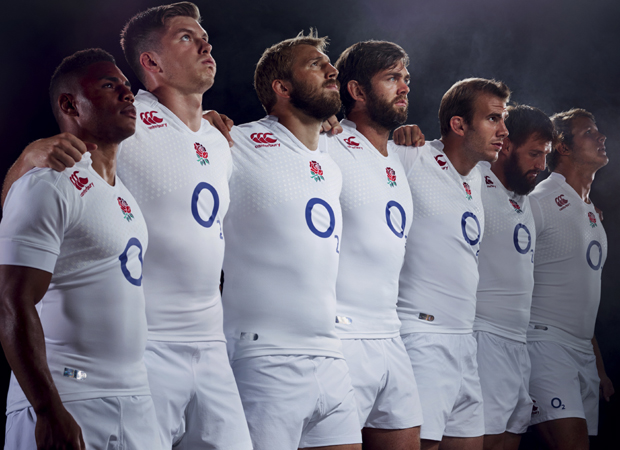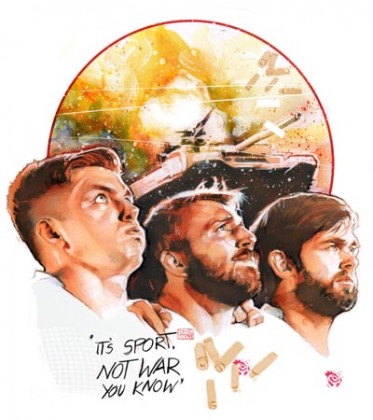 An essential part of the well-being of any professional (or amateur) sport is having strong and profitable relationships with commercial and broadcast partners, as is the case in Rugby Union. However, the operative word is partnership, and, as the RFU discovered this week, if you are not on your game your partners are capable of picking up your ‘product' and running with it in the wrong direction.
An essential part of the well-being of any professional (or amateur) sport is having strong and profitable relationships with commercial and broadcast partners, as is the case in Rugby Union. However, the operative word is partnership, and, as the RFU discovered this week, if you are not on your game your partners are capable of picking up your ‘product' and running with it in the wrong direction.
The controversy over the new England rugby shirt is a case in point. It began soon after the latest Red Rose jersey, produced by Canterbury, the RFU's current licensed kit manufacturer, was unveiled with a £91 price tag despite having only a ten-month shelf-life. After the 2014 autumn series and 2015 Six Nations are over the RFU have agreed to let the kit company replace it with a new design.
This was criticised in some quarters as unacceptable profiteering by the RFU at the expense of England fans, but the mire that the governing body had wandered into got stickier still when Canterbury's shirt design came under greater scrutiny.
The first ruction was a break with tradition which resulted in the Red Rose national emblem being moved from the left side of the chest – where it has been since England played their first international in 1872 – to the middle of the shirt, located over the sternum. Exactly why is difficult to fathom, especially as it gives opposition tacklers a target to aim at which is often where the ball is held.
There was a bigger furore to come when it emerged that the small rubber suckers attached to the fabric to give a non-slip grip around the chest area of the shirt were in the shape of the Victoria Cross, the British Armed Forces' paramount award for gallantry in combat.
Hearing about Stuart Lancaster's deliberate policy of connecting English players with their cultural and national identity last season struck me as sad, in the sense that England's head coach felt it was necessary. The teaching of the history of England in schools in this country has obviously slipped too far down the curriculum. What was also surprising was the adoption of Arthur Harrison VC for an award to be given by Lancaster and his coaches to the best England tackler on a match-by-match basis. It seemed inappropriate – and the decision by some marketing chump to take it a step further by stitching little Victoria Crosses onto the England shirt is as muddled as it gets.
 Rugby Union is justifiably proud of its strong links with the British Armed Forces. However, there is a world of difference between a robustly physical ball-playing sport, in which people partake whether at recreational or professional level for enjoyment, and the hell-on-earth carnage faced by service personnel in war, the incredibly brave Harrison among them.
Rugby Union is justifiably proud of its strong links with the British Armed Forces. However, there is a world of difference between a robustly physical ball-playing sport, in which people partake whether at recreational or professional level for enjoyment, and the hell-on-earth carnage faced by service personnel in war, the incredibly brave Harrison among them.
While playing for England with courage and tenacity in defence is the stuff of sporting dreams, it is not comparable with risking your life to protect or inspire others through an act of heroism in the face of bullet or bomb. That's why, in my view, Arthur Harrison's posthumous VC in the First World War has no place in a Red Rose dressing room award, irrespective of him being a former England forward. An award for outstanding defence named after Peter Winterbottom, Jonny Wilkinson, Neil Back, Joe Worsley or Matt Perry makes far better sense.
This is not the first time pro rugby has got its military wires crossed. Among Alastair Campbell's multiple miscalculations as the media manager on the hapless 2005 Lions tour was a speech he was allowed to give to the squad after the first Test defeat by New Zealand.
Lions lock Ben Kay described Campbell's address as “ridiculous”, for the following reasons: “He made comparisons with the Bosnian War, and SAS involvement in it, which had no place in sport. He was going on about people laying their bodies on the line, and suggesting we had not.”
Kay said Campbell's speech questioning the Lions commitment stuck in his craw, especially “from a guy who had never come close to playing rugby to any high standard”.
As for the England shirts, when the VC gaffe emerged the RFU was lambasted by Gary Stapleton, the chairman of the Victoria Cross Trust, whose volunteers work to restore VC graves. “It's very frustrating when you see the image being used for marketing purposes….and here's an organisation that's probably going to make quite a large amount of money from sales of said shirts.”
The secretary of the Victoria Cross and George Cross Association, Didy Grahame, took a similar view, commenting: “It's very disrespectful to use it out of context. That's quite wrong.”
Having tried initially to defend their position – but not with a great deal of courage or conviction – the RFU issued an apology “to those who may have taken offence with our new kit” and promised that it would be contacting both VC associations to support their worthwhile work.
Whether that ‘support' involved financial donations was not made clear, but if it did the RFU should be transparent and say so.
Not long afterwards the Victoria Cross and George Cross Association softened their shirt stance with a spokesman saying they were “pleased” the VC motif had been used and, “it is clear that the RFU did not intend to cause any offence”.
I'm sure it did not. But the RFU need to make sure that no more blundering flights of branding fancy, like linking pro rugby players with VC heroes, backfire on the England team in the build-up to the World Cup.
*This article was first published in The Rugby Paper on September 21.




























Pingback: tubulatura ventilatii